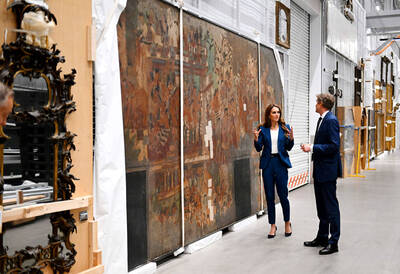Although tea drinking was made easier with the introduction of disposable paper cups and tea bags, many connoisseurs still believe that tea is best freshly brewed in a pot and drunk from porcelain cups.
In an effort to revive this tradition, the Beitou Museum (北投文物館) has organized an exhibition dedicated to the aesthetics of tea. In Manna Granted (人間甘露), the museum is showcasing over 300 objects used in the tea ceremonies of 13 countries, including Tibet, Japan, China, Turkey and Taiwan.
A Tibetan tea churn made in the 1900s and a Japanese silver teapot from the Meiji period are among the rare pieces valued by antique dealers and private collectors.

Photo Courtesy of Beitou Museum
To help visitors further indulge in the atmosphere, showrooms have been decorated with calligraphy, photographs and paintings with the same theme. Saalih Lee (李莎莉), director of the Beitou Museum, said there is more to tea than just the pleasure of drinking it.
“There’s a whole culture and history behind tea drinking, especially in Taiwan, where tea making and the tea trade date back many generations,” she said, sipping the aromatic beverage from a porcelain cup.
According to historical records, Taiwan began cultivating tea as early as 1717. Plantations were small in scale and farmers grew tea only for their own consumption. It was only when John Dodd, a British tea merchant, began exporting oolong tea overseas in the 1860s did Taiwan gain fame for its tea quality.

Photo Courtesy of Beitou Museum
One section of the exhibition displays Taiwan’s role in the international tea market. In the past, Lee noted, the nation’s tealeaves were sold under the brand Formosa, which is why the word Taiwan is rarely seen in old western posters and tin jars.
“Brewing a pot of tea and enjoying it with friends used to be the national pastime in Taiwan. However, the appearance of chilled tea in bottles and cans in 1985 changed that tradition. You don’t need tea implements to drink tea anymore,” she said.
Although teapots are slowly fading out of everyday use, artists with a passion for tea have cleverly incorporated the essence of tea culture into modern art. Lu Chih-song (盧志松) is among the talents who are showcasing their creativity at the venue.
Lu, a polio survivor, spent two years carving 100 miniature teapots out of coral, each with a different shape and size. The smallest teapot is 3mm in length and can only hold a drop of water. The tea pots were arranged to illustrate the Chinese characters Bai Fu (百福), or good fortune.
For Lee, tea culture isn’t a fading tradition. “If you think about it, tea drinking could be a living form of art that elevates life,” she said.

June 9 to June 15 A photo of two men riding trendy high-wheel Penny-Farthing bicycles past a Qing Dynasty gate aptly captures the essence of Taipei in 1897 — a newly colonized city on the cusp of great change. The Japanese began making significant modifications to the cityscape in 1899, tearing down Qing-era structures, widening boulevards and installing Western-style infrastructure and buildings. The photographer, Minosuke Imamura, only spent a year in Taiwan as a cartographer for the governor-general’s office, but he left behind a treasure trove of 130 images showing life at the onset of Japanese rule, spanning July 1897 to

One of the most important gripes that Taiwanese have about the Democratic Progressive Party (DPP) is that it has failed to deliver concretely on higher wages, housing prices and other bread-and-butter issues. The parallel complaint is that the DPP cares only about glamor issues, such as removing markers of Chinese Nationalist Party (KMT) colonialism by renaming them, or what the KMT codes as “de-Sinification.” Once again, as a critical election looms, the DPP is presenting evidence for that charge. The KMT was quick to jump on the recent proposal of the Ministry of the Interior (MOI) to rename roads that symbolize

On the evening of June 1, Control Yuan Secretary-General Lee Chun-yi (李俊俋) apologized and resigned in disgrace. His crime was instructing his driver to use a Control Yuan vehicle to transport his dog to a pet grooming salon. The Control Yuan is the government branch that investigates, audits and impeaches government officials for, among other things, misuse of government funds, so his misuse of a government vehicle was highly inappropriate. If this story were told to anyone living in the golden era of swaggering gangsters, flashy nouveau riche businessmen, and corrupt “black gold” politics of the 1980s and 1990s, they would have laughed.

Imagine being able to visit a museum and examine up close thousand-year-old pottery, revel alone in jewelry from centuries past, or peer inside a Versace bag. Now London’s V&A has launched a revolutionary new exhibition space, where visitors can choose from some 250,000 objects, order something they want to spend time looking at and have it delivered to a room for a private viewing. Most museums have thousands of precious and historic items hidden away in their stores, which the public never gets to see or enjoy. But the V&A Storehouse, which opened on May 31 in a converted warehouse, has come up